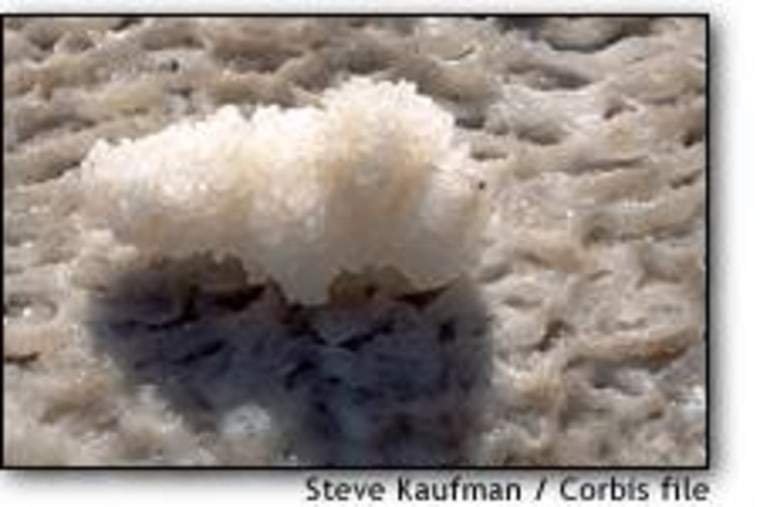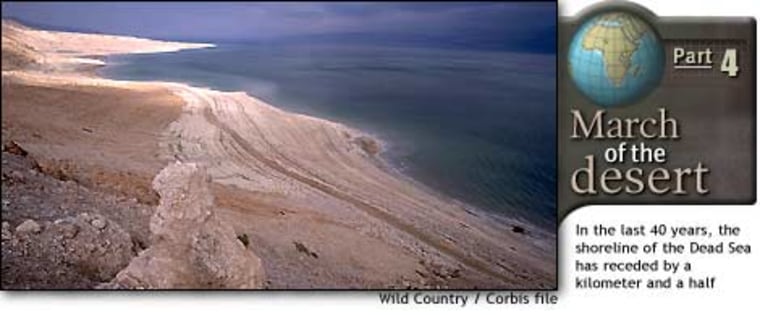Here at the lowest point on earth — 1,476 feet below sea level — a sign at the Mineral Beach and Spa warns bathers not to swim out beyond it. These days, it is unlikely anyone will disobey. That’s because the shoreline of the Dead Sea has receded an amazing 50 yards in a matter of years — a sign, scientists say, that this most famous of inland seas truly is dying.
In the last 40 years, the water level of this biblical landmark has dropped by more than 262 feet. Thus, the lowest point on earth keeps getting lower, mostly because 90 percent of the rivers that feed this body of water is being diverted to farmland, hydroelectric projects and cities.
“The Dead Sea level is declining,” said Elias Salameh, a hydrologist at Jordan University’s Faculty of Science. “The area is shrinking, tourist facilities are too far away.”
The Middle East is a thirsty region. Drought conditions and growing populations in Jordan, Israel and the Palestinian territories are placing heavier burdens on the area’s freshwater supplies - namely the Jordan and Yarkon rivers and the Sea of Galilee. Which means less water for the Dead Sea. But is anything being done to save it?
“The Dead Sea will stop declining at a certain point,” said Meir Ben-Meir, the Israeli Water Commissioner. To him, Israel’s water needs are far more pressing than the fate of the Dead Sea, whose heavily-salinated, brackish waters are viewed as being unimportant as a source of usable water. Their ecological and tourist value, of course, is another matter.
“We don’t think of the Dead Sea when we refer to water scarcity,” he said. “Instead of feeding the Dead Sea, let’s revive a dead desert.”
Raising the dead
Israel actually did consider a huge project in the 1980s that would have helped to save the Dead Sea. A proposed canal from the Mediterranean to the Dead Sea, the “Dead-Med” project, was studied in hopes of generating hydroelectric power as the water plunged downhill.

The electricity would be used to desalinate the water, which could then be put to human or agricultural use. Water that was not processed would have been allowed to flow into the Dead Sea. But like many plans involving desalinization, this one was ultimately shelved because it was deemed too expensive.
But the concept of pumping water into the Dead Sea has not been totally dismissed. The 1994 peace treaty between Israel and Jordan stipulated that both countries should cooperate on some sort of canal project. For their part, the Jordanians have kept the dream alive.
“The Jordanian government is very much concerned about the declining level of the Dead Sea,” said Kamel Mahadine, the Jordanian Minister of Irrigation and Water, in response to questions from MSNBC. “Jordan’s total projected water supplies from all sources indicate that our water deficit is increasing with time.”
Salt in the wound
Jordan’s concern about the decline of the Dead Sea relates partly to its need to use every available water source. According to a Jordanian scientific study, groundwater supplies near the Dead Sea are deteriorating as the shoreline recedes. As the sea level drops, salty groundwater is pulled into the Dead Sea. The empty space formerly occupied by the salt water is then replaced by fresh groundwater. This displaced fresh water is then salinated by the ground that still contains a high amount of salt residue. This salt contamination further reduces the amount of fresh water supply in the Dead Sea region.
So Jordanians are keen to see some sort of project to save the Dead Sea. They have been looking seriously at a “Red-Dead” route: pumping water from the Red Sea’s Gulf of Aqaba up the coastal ridge and then downhill through the Jordan Rift Valley to the Dead Sea. That’s a plunge of 533 vertical meters and a potential a source of hydro-power. But this project could cost as much as $5 billion.
“Jordan can’t afford it,” Salameh said. “Consensus needs to be reached between Jordan and Israel. The canal has to be used by both countries.”
Better red than med?
Economics is not the only stumbling block to the Red-Dead idea. No one is sure what would happen if waters from two different bodies of salt water are mixed. In theory, given their differing densities and salt composition, they would not mix, creating two separate layers. Some scientists think that the sea could turn from clear blue to milky white, or even pink.

“We would be very concerned because of the potentially negative environmental impacts.” said Gidon Bromberg of Friends of the Earth Middle East about the possibility of a Red-Med-Dead canal. “There has been no thorough assessment yet.”
The only viable short-term solution for now seems to be to somehow decrease the burden on the freshwater supply that is being diverted away from the Dead Sea. Israel is now using treated sewage water for part of its agricultural consumption. It is also planning to build a desalinization plant along the Mediterranean Sea which could be producing fresh water within four years.
“The more artificial water that we introduce to the region, the less that we have to sometimes overuse from current fresh resources,” Israel’s Ben-Meir said.
Which means that the Dead Sea may still have a fighting chance. But its rescue will not come from any concerted and deliberate effort to save it.
Hanson Hosein is an NBC News producer based in Tel Aviv.
